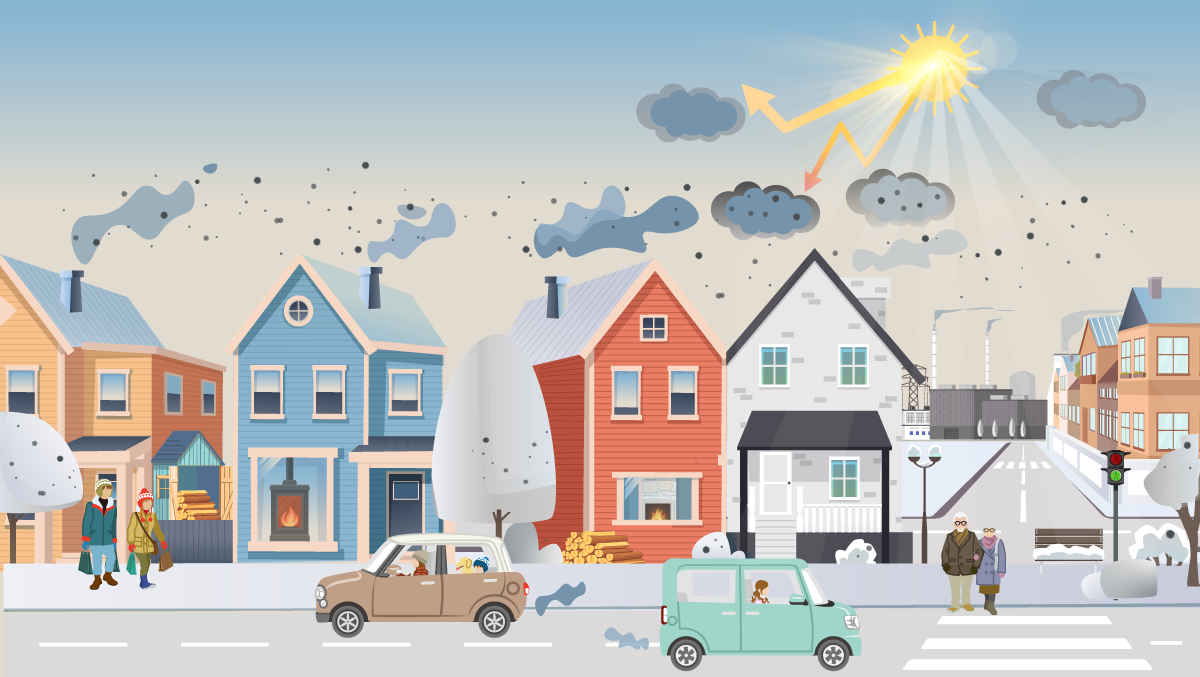Black carbon concentrations can now be monitored in real time in our online service

Real-time information on black carbon concentrations in different environments and different parts of Finland provides a more accurate picture of the sources and concentration variations of particulates resulting from combustion. This information is needed as we prepare for the EU's tightening ambient air quality legislation.
Traffic and burning of wood are the most significant sources of black carbon in cities
Black carbon, or soot, is formed as a result of incomplete combustion. In Finland, most black carbon emissions are produced by old diesel vehicles and by burning wood in fireplaces. The increased use of firewood for heating due to the energy crisis also increases black carbon emissions, which may cause air quality problems or smoke harm in dense low-rise areas.
So far, black carbon has been extensively measured only in the Helsinki region, where the air quality measurements are conducted by Helsinki Region Environmental Services HSY. The monitoring of black carbon began in the region in 2009, and measurements are now carried out in seven locations. “Over the years, black carbon concentrations have decreased considerably in traffic environments with the renewal of the vehicle fleet. In low-rise areas, wood burning continues to have a major impact on the concentrations, especially in calm and frosty evenings”, says Hanna Manninen, Head of Air Quality Unit at HSY. Real-time information on black carbon concentrations gives a much better picture of local emission sources than, for example, fine particle concentrations, which are more strongly influenced by long-range transport than local emissions. “We hope that the inclusion of black carbon in the real-time air quality monitoring service encourages other cities to include it in their monitoring programmes as well,” says Pia Anttila, Research Scientist at the Finnish Meteorological Institute.
Research station results included in the service
Due to the results of the research stations of the Finnish Meteorological Institute and University of Helsinki, the black carbon measurement network now expands to cover all of Finland. Research stations scattered across the country provide a comprehensive picture of air pollutants entering Finland. Black carbon also accelerates climate change. It has a strong warming effect in the atmosphere, and it also affects cloud formation processes, among other things, which makes it an important research target. In northern research stations, the Finnish Meteorological Institute's Sammaltunturi station and the University of Helsinki's Värriö research station, black carbon is detected especially as a long-range transport from gas and oil fields in the north of Russia and extensive forest fires in Siberia. “Black carbon accelerates climate change in the Arctic, and accurate measurements of the area are important for assessing the impacts,” says Antti Hyvärinen, Head of Unit at the Finnish Meteorological Institute. Measurements from the Hyytiälä station in Juupajoki and the Puijo station in Kuopio provide a perspective on black carbon loading in southern and central Finland. The location of the Utö station is ideal for studying and monitoring loading from both maritime transport and continental Europe.
Black carbon emissions and air concentrations to come under regulation in the future
Black carbon has adverse effects on human health due to the harmful organic compounds and metals bound to its surface. Black carbon particles can be very small, allowing them to pass through the human body all the way to the alveoli. Short-term exposure to high concentrations aggravates cardiac and respiratory diseases, for example. National or international air quality standards have not yet been set for black carbon. However, both the European Union and the World Health Organisation (WHO) have drawn their attention to black carbon due to its threat to health and climate, which signals that emissions and air concentrations could come under regulation in the future.
Further information
Air quality in Finland - Choose Black carbon from the right side of the map Pia Anttila, Senior Scientist, tel. +358 50 368 6420, pia.anttila@fmi.fi Pallas Atmosphere Ecosystem Supersite Utö Atmospheric and Marine Research Station Antti Hyvärinen, Head of Unit, tel. +358 29 539 5444, antti.hyvarinen@fmi.fi Eija Asmi, Head of Group, tel. + 358 29 539 5352, eija.asmi@fmi.fi
Helsinki Kumpula measurement station Hilkka Timonen, Head of Group, tel. + 358 29 539 5503 hilkka.timonen@fmi.fi
Kuopio Puijo research station Mika Komppula, Head of Group, tel. +358 29 539 5413, mika.komppula@fmi.fi
University of Helsinki Värriö SMEAR I Hyytiälä SMEAR II Tuukka Petäjä, Professor, tel. +358 50 415 5278, tuukka.petaja@helsinki.fi
Helsinki Region Environmental Services HSY stations Hanna Manninen, Head of Air Quality Unit, tel. +358 50 401 7826, hanna.manninen@hsy.fi
